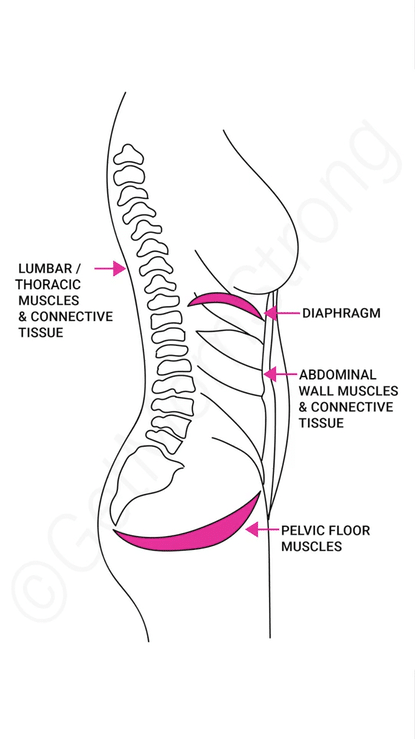Motherhood is stressful, and many of our day-to-day postural habits can cause a tight, or hypertonic pelvic floor. This happens when your pelvic muscles do not relax when they should. This can lead to a host of uncomfortable symptoms, from chronic pain to constipation.
What is Hypertonic Pelvic Floor?
Hypertonic pelvic floor refers to when the pelvic floor muscles are unable to relax. This constant state of contraction can lead to a host of symptoms.
They include: pelvic muscle spasms, pain while urinating/releasing bowel movements, lower back pain and pelvic discomfort.
What Causes a Tight Pelvic Floor?
There are many reasons a pelvic floor might become chronically tight. Often, it’s a cumulative effect, and not necessarily one thing alone.
Common causes include:
- Stress
- Sucking in your belly
- Gripping your butt
- Sexual trauma
- Holding urine for extended periods
- Doing too many kegels
- Fear around prolapse
Tight vs. Weak Pelvic Floor
According to Justine Williams Roper, a pelvic floor physical therapist with InHer Physique, a hypertonic pelvic floor occurs when the pelvic muscles are in a constant state of contraction.
“Think of a person flexing their bicep nonstop. When the muscles are constantly contracted, they won’t work properly,” she says. “Similarly, a tight pelvic floor isn’t a ‘good’ or ‘strong’ pelvic floor.”
A weak pelvic floor means that the muscles are weak and uncoordinated. For example, when you sneeze, a properly functioning pelvic floor will reflexively lift. If yours is weak, it won’t react properly, which can result in leaking.
“It is possible to have both a weak (hypotonic) AND tight (hypertonic) pelvic floor. I like to use the example of a lady bent over with her shoulders shrugged, typing on a computer all day,” said Dr. Roper. “After years of doing this daily, you ask her to go to the gym and do shoulder shrugs with 50-100 pound dumbbells. She likely won’t be able to because she lives day-to-day with shortened, tight muscles. She can’t grow and build proper strength with such a small range of motion. The same goes for the pelvic floor.”
How to Know if Pelvic Floor is Tight or Weak:
Pelvic floor dysfunction is common.
Signs and symptoms that commonly accompany a hypertonic pelvic floor include:
- Constipation, need to strain, or difficulty releasing bowel movements
- Hesitancy or delayed start of urine stream
- Urinary urgency or incontinence
- Incomplete emptying the bladder
- Painful sex
- Chronic low back, tailbone, or hip pain
- Pelvic pain
- A history of sexual trauma is common among women with pelvic floor disorders. While not a symptom, it often results in chronic pelvic pain.
If you have any of these symptoms, you may be dealing with a tight pelvic floor. But the only way you can know for sure is by seeing a pelvic health professional.
“I do not recommend anyone ‘self-diagnose,’” said Dr. Roper. “A pelvic floor PT will perform a pelvic exam to assess pelvic floor muscle tone, reflexes and whether you have a prolapse or not. They will also check your ability to voluntarily control pelvic floor muscles, core strength and much more.”
Pelvic floor tightness is so common, so many people will see even the most subtle change by performing relaxation techniques.
Treatment for Hypertonic Pelvic Floor
So what are these techniques? Is a hypertonic pelvic floor treatable? In short, yes – you can retrain your muscles. Here are key ways to promote pelvic floor muscle relaxation:
Breathwork to Release Your Pelvic Floor
Connect the breath and your pelvic floor. Work daily on deep abdominal breathing techniques:
- Sit comfortably with a hand on your chest and the other on your abdomen.
- Inhale down into your body, expanding your rib cage like an umbrella. Overflow air will flow gently into your tummy. You should feel abdominal muscles move, while the hand on your chest remains still.
- As you exhale, your pelvic floor will naturally recoil and release. Don’t actively lift it.

Kegels Aren’t the Answer
Take it easy on the kegels. These infamous pelvic floor squeezes only work one way. Your muscles tighten. This can worsen an already tight pelvic floor.
Instead, focus on moving the pelvic floor through its full range of motion. Deep abdominal breathing engages both the diaphragm and pelvic floor. It also supports muscle function and can help reduce pain.
When we have pelvic floor tension, it’s important to learn to lengthen and release it.
Break Bad Habits
Stop butt gripping and sucking in your belly. These two postural habits can create even more tension within pelvic floor muscles. When seated, instead of tucking your butt under, think about sitting evenly on your sit bones.
Learn to Contract and Relax Your Pelvic Floor During Exercises
During exercise, focus on the inhale and exhale. Inhaling and relaxing your pelvic floor is as important as lifting and contracting the pelvic floor when exercising.
For example, during a squat, inhale down into the body as you lower down. Then exhale and lift pelvic floor as you stand.
Strengthen Nearby Muscles
Incorporate moderate stability exercises (functional movement training) to the muscles surrounding the pelvis. When your core and pelvic floor have support from other body parts, it is more likely to let go.
If work through these treatments and something doesn’t feel right, please reach out to a professional.
How Long Does it Take to Fix?
How long it takes to “fix” a hypertonic pelvic floor is unique to each person, says Dr. Roper. “If a provider of any kind says they can get you better in a certain time, that can be misleading. I have treated a patient for two weeks with successful mitigation of their symptoms. I have also seen a patient with several pelvic conditions for months.”
She makes sure her patients learn something new at each session to work on their issues. She views physical therapy as “a way to improve the way you exist in your world by changing habits.”
Is It Ever Too Late to Fix an Overactive Pelvic Floor?
It is never too late to improve a hypertonic pelvic floor. The key is to identify the ‘why.’ What is contributing to the issue?
Taking a whole body approach is key in improving a hypertonic pelvic floor and its symptoms. The SLAM Stretch program has a variety of relaxation & release work that can help.
“Is it a central nervous system response to stress? Are there other muscles in the body that are weak and causing strain to the pelvic floor? Is there a history of trauma that needs to be addressed with care from another provider?” Dr. Roper says, “It requires lots of investigative work. Once there’s a foundation set, there are many ways to fix hypertonic pelvic floor issues.”
